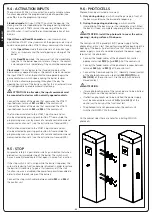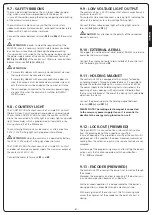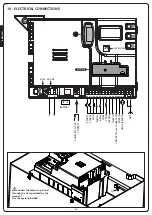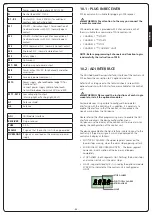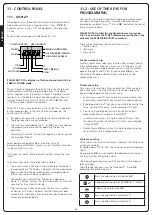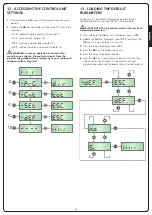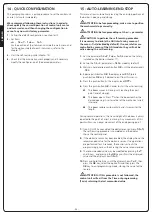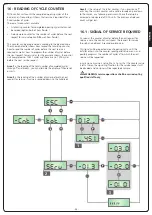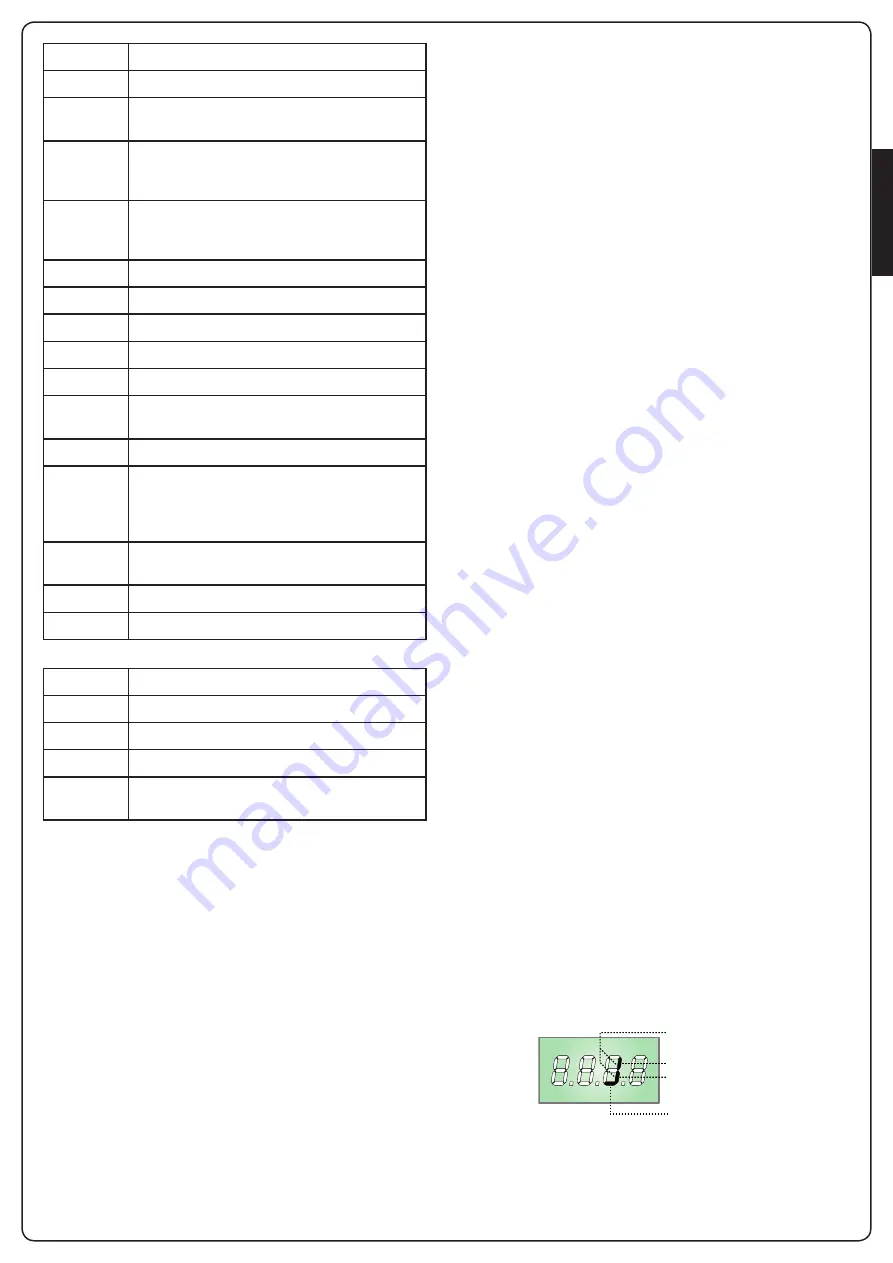
ENGLISH
- 49 -
L
Power supply feeding phase 230V / 120V
N
Neutral feed 230V / 120V
B1 - B2
Contact N.A. (max. 230V-5A) for additional
courtesy light or flashing light
M1
START1 – Activation input 1 for connection of
traditional devices with N.O. (normally open)
contact
M2
START2 - Activation input 2 for connection of
traditional devices with N.O. (normally open)
contact
M3
STOP Command. N.C. (normally closed) Contact
M4
Photocell. N.C. (normally closed) contact
M5
Safety ribbon
M6
Common (-)
M7 - M8
Holding magnet power output
M8
Power output 24VDC for photocells and other
accessories
M9
Accessory power common (-)
M10
Power supply - photocell/optical edge TX for
functional Test.
Connect power supply cables of photocells
transmitter between terminals M10 and M9
M11 - M12
Low voltage light output
(Warning light or flashing light (24V))
A1
Antenna shield
A2
Antenna
ADI
ADI Module interface
RECEIVER
Plug in receiver
FUSE
2,5 A
MAINS
It signals that the control unit is being powered
OVERLOAD
It signals an overload on the accessories power
supply
10.1 - PLUG IN RECEIVER
PD16 control unit is suitable for plugging in MR receiver.
m
WARNING: Pay attention to the way you connect the
removable modules.
MR module receiver is provided with 4 channels and each of
them is suitable for a command of PD16 control unit:
• CHANNEL 1
g
START1
• CHANNEL 2
g
START2
• CHANNEL 3
g
STOP
• CHANNEL 4
g
COURTESY LIGHT
NOTE: Before programming 4 channels and function logics
read carefully the instructions of MR.
10.2 - ADI INTERFACE
The ADI (Additional Devices Interface) interface of the control unit
PD16 allows the connection to V2 optional modules.
Refer to V2 catalogue or to the technical sheets to see which
optional modules with ADI interface are available for this control
unit.
m
WARNING: Please read the instructions of each single
module to install the optional modules.
For some devices, it is possible to configure the mode for
interfacing with the control unit; in addition, it is necessary to
enable the interface so that the control unit can process the
signals arriving from the ADI device.
Please refer to the
i.Adi
programming menu to enable the ADI
interface and access the device configuration menu.
ADI devices use the display of the control unit to issue alarms or
display the configuration of the control unit.
The device connected to the Adi interface is able to signal to the
control unit three alarm signals, which are displayed on the
control unit display as follows:
• PHOTOCELL ALARMS - the upper segment comes on: the
barrier stops moving, when the alarm stops opening restarts.
• EDGE ALARM / ENCODER SENSITIVITY - the lower segment
comes on: inverts motion of the barrier and reopens
completely.
• STOP ALARM - both segments start flashing: the barrier stops
and cannot restart until the alarm stops.
• SLAVE - segment steadily lit: it is used by the optional module
SYNCRO to indicate that the control unit is configured as
SLAVE.
PHOTOCELL ALARM
STOP ALARM
EDGE ALARM
SLAVE
Summary of Contents for NIUBA-24V
Page 2: ...1153 mm 320 mm 287 mm 218 mm 897 mm 1168 mm 374 mm 239 mm 319 mm 897 mm ...
Page 7: ...ITALIANO 5 NIUBA4 NIUBA6 ...
Page 11: ...ITALIANO 9 FIG 3 FIG 4 ...
Page 13: ...ITALIANO 11 A D E C F F G E A B D C O N M ...
Page 31: ...ITALIANO 29 ...
Page 34: ...ITALIANO 32 ...
Page 39: ...ENGLISH 37 NIUBA4 NIUBA6 ...
Page 43: ...ENGLISH 41 FIG 3 FIG 4 ...
Page 45: ...ENGLISH 43 A D E C F F G E A B D C O N M ...
Page 63: ...ENGLISH 61 ...
Page 66: ...ENGLISH 64 ...
Page 71: ...FRANÇAIS 69 NIUBA4 NIUBA6 ...
Page 75: ...FRANÇAIS 73 FIG 3 FIG 4 ...
Page 77: ...FRANÇAIS 75 A D E C F F G E A B D C O N M ...
Page 95: ...FRANÇAIS 93 ...
Page 98: ...FRANÇAIS 96 ...
Page 103: ...ESPAÑOL 101 NIUBA4 NIUBA6 ...
Page 107: ...ESPAÑOL 105 FIG 3 FIG 4 ...
Page 109: ...ESPAÑOL 107 A D E C F F G E A B D C O N M ...
Page 127: ...ESPAÑOL 125 ...
Page 130: ...ESPAÑOL 128 ...
Page 131: ......












